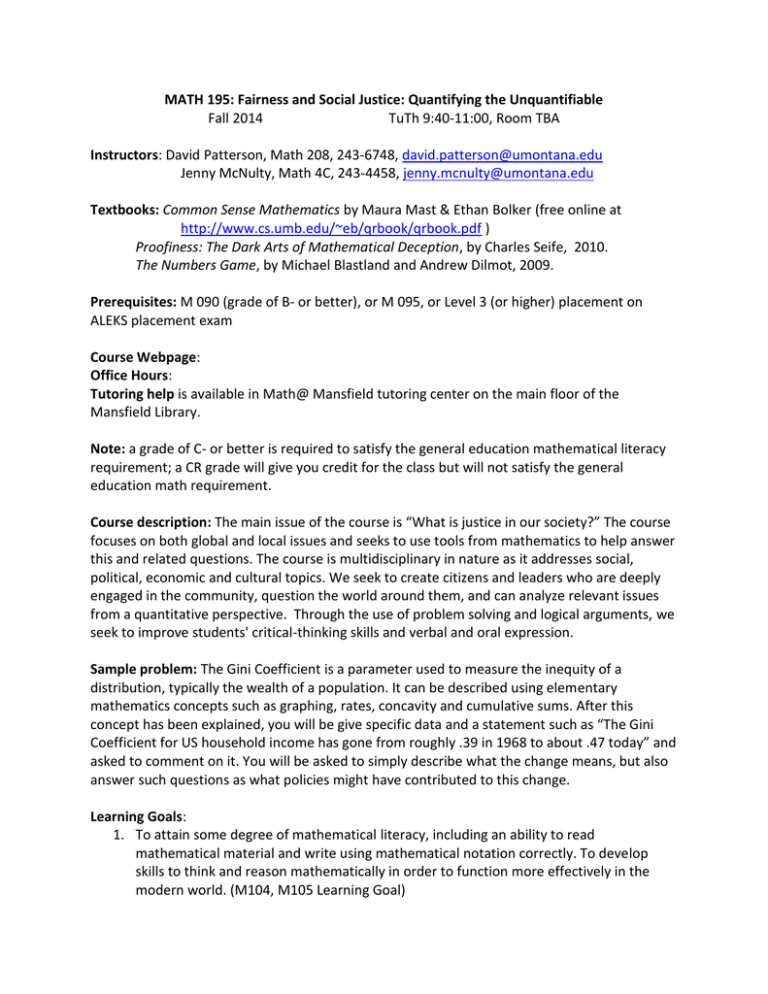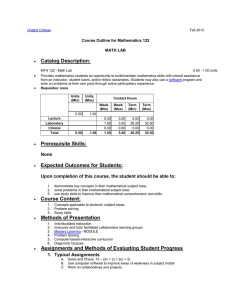MATH 195: Fairness and Social Justice: Quantifying the Unquantifiable Instructors Textbooks: Prerequisites:
advertisement

MATH 195: Fairness and Social Justice: Quantifying the Unquantifiable Fall 2014 TuTh 9:40-11:00, Room TBA Instructors: David Patterson, Math 208, 243-6748, david.patterson@umontana.edu Jenny McNulty, Math 4C, 243-4458, jenny.mcnulty@umontana.edu Textbooks: Common Sense Mathematics by Maura Mast & Ethan Bolker (free online at http://www.cs.umb.edu/~eb/qrbook/qrbook.pdf ) Proofiness: The Dark Arts of Mathematical Deception, by Charles Seife, 2010. The Numbers Game, by Michael Blastland and Andrew Dilmot, 2009. Prerequisites: M 090 (grade of B- or better), or M 095, or Level 3 (or higher) placement on ALEKS placement exam Course Webpage: Office Hours: Tutoring help is available in Math@ Mansfield tutoring center on the main floor of the Mansfield Library. Note: a grade of C- or better is required to satisfy the general education mathematical literacy requirement; a CR grade will give you credit for the class but will not satisfy the general education math requirement. Course description: The main issue of the course is “What is justice in our society?” The course focuses on both global and local issues and seeks to use tools from mathematics to help answer this and related questions. The course is multidisciplinary in nature as it addresses social, political, economic and cultural topics. We seek to create citizens and leaders who are deeply engaged in the community, question the world around them, and can analyze relevant issues from a quantitative perspective. Through the use of problem solving and logical arguments, we seek to improve students' critical-thinking skills and verbal and oral expression. Sample problem: The Gini Coefficient is a parameter used to measure the inequity of a distribution, typically the wealth of a population. It can be described using elementary mathematics concepts such as graphing, rates, concavity and cumulative sums. After this concept has been explained, you will be give specific data and a statement such as “The Gini Coefficient for US household income has gone from roughly .39 in 1968 to about .47 today” and asked to comment on it. You will be asked to simply describe what the change means, but also answer such questions as what policies might have contributed to this change. Learning Goals: 1. To attain some degree of mathematical literacy, including an ability to read mathematical material and write using mathematical notation correctly. To develop skills to think and reason mathematically in order to function more effectively in the modern world. (M104, M105 Learning Goal) 2. To examine ways in which mathematics is used, to follow and understand logical arguments, and to solve applied quantitative problems. This includes learning to formulate a problem precisely, to interpret solutions, and to make critical judgments in the face of competing formulations and solutions. (M104, M105 Learning Goal) 3. To understand, analyze and use data in a variety of formats and presentations. This will include a study of statistical parameters, correlation, association & causation, graphical and numerical representation of data (scatter plots, box plots, measures of center and spread, etc.), graphing and properties of functions, number sense, percentages, probability, surveys, experiments, algorithms. 4. To create a written argument that is logically sound and uses facts and data to support a conclusion. Course Structure: The course will be student centered instruction that will encourage both the student and teacher to understand how mathematics fits into the fabric of our lives. We will use a variety of teaching methods including Inquiry based learning and the flipped classroom environment. Guest speakers and video clips will also be used to highlight a particular political, economical, racial or cultural issue. Real data sets, reports, budgets, articles will also be used. Student assessment will involve knowledge of the social justice issues as well as the mathematical concepts. Assignments will be a mix of open ended questions which will involve written arguments of varying length and mathematical calculations and analyses. Course materials will be created by the instructors and will build on the resources of the mathematical community (see references). Grading (+/- grading will be used): Attendance & Participation Mini-tests Homework Reading and Commenting on the News Project Paper 10% 20% 20% 10% 20% 20% Attendance & Participation: Attend all classes, prepared to discuss assigned readings and problems, and contribute to discussions. Preparation includes completing all assigned readings before class and taking a short online reading quiz once a week. Mini- tests: We will have 5-6 mini tests; low score will be dropped. Dates will be announced as we go and will generally be as we finish a chapter or section of material. Homework: We will have weekly homework assignments. Some problems will be discussed in class, some will be handed in and graded. The problems will be a mix of open-ended problems and routine calculations. There will be problems of a mathematical nature and problems asking you to write a position piece about an assigned topic, supporting opinions with facts and data analysis. Reading and Commenting on the News: Part of quantitative literacy is being able to critically interpret numbers and mathematics in the news media. Each week, you’ll be asked to critique the numbers or mathematics contained in an article related to an issue of social justice. You’ll also be asked to respond to someone else’s report. These assignments will be completed online using Moodle discussion forums. Projects: We will work to enact justice through a semester-long project. Early in the semester you will be required to write up a proposal for a project that aims to change the world in a small but important way. In a single page, you should layout the basic issue you hope to address, how mathematics will be needed to understand and address it, what your initial plan of attack is, and what you hope to accomplish this semester on your issue. In class, you will have an opportunity to pitch your idea to the class, with the goal of attracting other students to your cause. After everyone has pitched their ideas, we will vote and divide into small groups, each tackling one proposal, or a combination of several closely related proposals. The project will last the rest of the semester as you work to study the issue, understand it better using mathematics, and work toward change. Each group will be asked to report to the class periodically on their progress. Paper: The course will culminate with a final paper; a 5-10 page “white paper” on a topic of your choosing. This is an in-depth paper that builds on the previous assignments. There will be intermediate deadlines and drafts of the paper will be critiqued by the instructor and other students. Incompletes are given at the discretion of the instructor and are only considered in cases where a. the student has been in attendance and doing passing work up to three weeks before the end of the semester, and b. for reasons beyond the student’s control and which are acceptable to the instructor, the student has been unable to complete the requirements of the course on time. Negligence and indifference are not acceptable reasons. Students with disabilities are welcome to discuss accommodations with the instructors. Academic Honesty All students must practice academic honesty. Academic misconduct is subject to an academic penalty by the course instructor and/or a disciplinary action by the University. All students need to be familiar with the Student Conduct Code. You can find it in the A-Z index on the UM home page.




